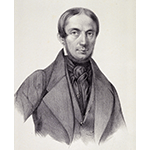Filippo Civinini
After having begun his medical studies in Pistoia, his native city, he went on to specialise at Pisa, where he took his degree in 1825. Starting in 1834 he was appointed, at this same university, to the post of anatomical dissector, and two years later, to the Chair of Human Anatomy. It was at his initiative that the Pisa Anatomical-Physical-Pathological Museum, one of the largest collections of anatomical preparations of the time, was founded. Thanks to his fame as an outstanding scholor, he was nominated to numerous Italian academies, and his school was attended by some of the leading surgeons of the next generation, such as Atto Tigri (1813-1875) and Filippo Pacini (1812-1883). He died prematurely at Pisa in 1844. Civinini's most original contributions are relevant to the field of osteology, and in particular to the cranium, whose bones and morphological variations he described for the first time with great precision. Noteworthy among his works are the Linee anatomiche I, Osteologia [Anatomical lines I, Osteology] (1829) and Linee anatomiche II, sulla scissura di Glaser in temporale [Anatomical lines II, on Glaser's temporal fissure](1830).
Last update 31/gen/2008




